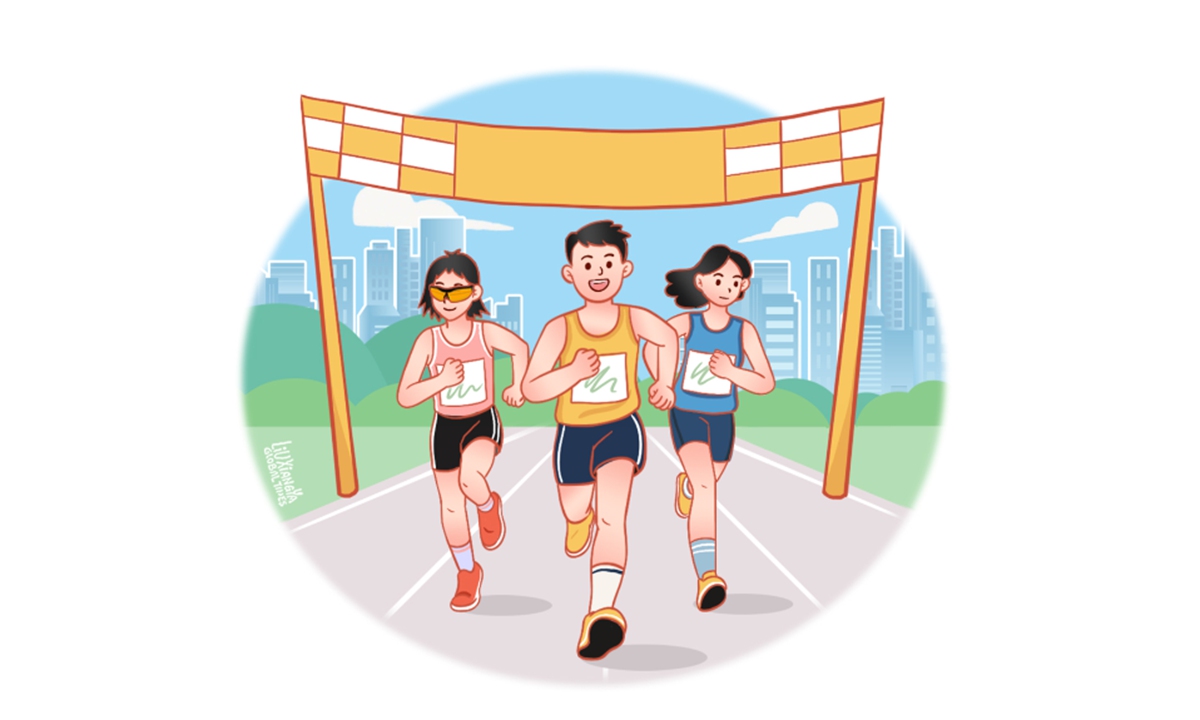
Illustration: Liu Xiangya/GT
In recent years, marathons in China have evolved into spectacular public events, drawing tens of thousands of participants and electrifying local communities with their promise of health and city pride. On Sunday alone, nearly 30 marathon/half-marathon races, ranging from Xiangshan in East China's Zhejiang Province to Dazhou in Southwest China's Sichuan Province, were held even though extreme weather conditions forced some to postpone.
Yet behind the vibrant energy and fervor of these mass events lurk serious questions about regulatory oversight and public safety that can no longer be ignored. A series of incidents, such as allowing underage runners to compete in events meant for adults, raise critical concerns about whether the spirit of sports is being undermined.
In one widely reported case during the 2025 marathon season, the race organizers of a half-marathon event in Zunyi in Southwest China's Guizhou Province in March raised eyebrows as a 12-year-old was "specifically invited" to compete.
The organizers justified their decision by citing a signed disclaimer from the participant's family, a practice that, while legally permissible in some contexts, does little to mitigate the inherent health risks involved.
Medical experts and fitness coaches are unanimous in their views. The physical demands of long-distance running place significant strain on a developing body. Prolonged endurance events subject the skeletal system, cardiovascular system and overall physical structure to stress that can lead to irreversible damage, especially for teenagers.
When race organizers allow or even encourage the participation of children far below the standard age thresholds, they expose young athletes to long-term health complications that could curtail their future potential and quality of life.
Scrutiny of official documents and registration platforms for these events further reveals that the mandated age limits for marathon and half-marathon races are clearly defined. For example, full marathons require participants to be at least 20 years old and half-marathons to be 16, as indicated by the national guidelines overseen by the Chinese Athletics Association.
Domestic marathon events often feature fun runs, which are designed for running enthusiasts who are not ready to take on the challenge of a long-distance race and are often more relaxed. They allow participation by younger athletes provided an adult accompanies them. These rules are based on thorough scientific health and performance assessments overseen by institutions.
However, some organizers have gone so far that even a toddler has been seen taking part in a race.
The participation of such a young child in such an event contradicts these safety protocols. A child's physical development is not suited for the rigorous activity that a marathon, or even a short fun run, entails.
Yet, whether it was a simple administrative oversight or a deliberate attempt to gain media attention by having an underage runner remains unclear, fueling a debate about the risks of prioritizing publicity over participants' well-being.
The event in question set a dangerous precedent, highlighting a concerning trend in which race organizers, in pursuit of higher participation rates and enhanced visibility, sidestep critical safety norms. This case is hardly isolated.
The rules are deliberately set to ensure that participants are physically and mentally prepared for the strenuous activity, balancing the excitement of mass participation with the need for personal safety.
Despite clearly stated guidelines, there has been a repeated pattern of deviation from these rules.
In addition to the underage participation issues, instances of unsportsmanlike conduct, such as runners relieving themselves in inappropriate locations, have also resurfaced.
The casual attitude toward such violations indicates that the current system of penalties, like short-term disqualifications or small fines, might not be sufficient to deter non-compliance.
Critics argue that without more robust enforcement mechanisms, the marathon culture risks eroding not only the physical safety of its participants but also the overall spirit and reputation of the sport.
The situations call for a reform of the industry's regulatory framework. Such a framework would involve detailed age and health checks, the establishment of a national blacklist for repeat offenders, and tougher sanctions for venues that allow dangerous deviations from the established norms.
This "safety valve" could help ensure that the fundamental integrity of these competitions is maintained, prioritizing the health and well-being of all participants over commercial and sensational interests.
Public sentiment appears to echo these concerns.
Many local residents and seasoned athletes have expressed frustration that the rush to capitalize on the popularity of marathons has led to oversights that could eventually have dire consequences.
The prevailing view is that while enthusiasm for running and public participation in sports should be encouraged, it must not come at the cost of safety or common sense.
Events that mix carelessly arranged attractions and quirky stunts with high-stakes athletic competitions can easily blur the line between genuine athletic endeavors and a spectacle that undermines core sports values.
Moreover, the current state of race organization has broader social implications.
A marathon is more than just a competitive event, it is often a reflection of a community's commitment to health and civic pride.
As cities invest in marathon events to boost local economies and promote tourism, the risk of reputational damage becomes real.
A single incident involving a toddler or an underage athlete can quickly escalate into a national debate about the priorities and ethics of event management.
It is incumbent upon regulators, sports associations, and race organizers to work together, adopt more stringent measures, and communicate clearly with the public about the inherent risks involved in these extreme endurance events.
Only then can marathons truly be celebrated as events that uplift a community, promote a healthy lifestyle, and inspire the next generation without compromising the well-being of the vulnerable participants.
The author is a reporter with the Global Times. life@globaltimes.com.cn




